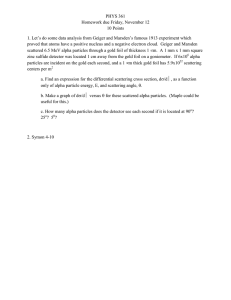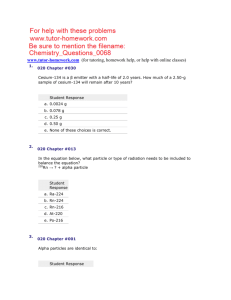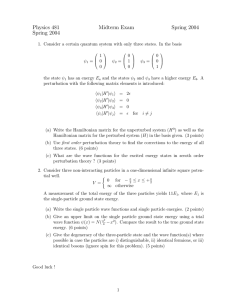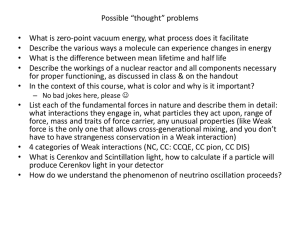22.101 Quiz No. 2
advertisement
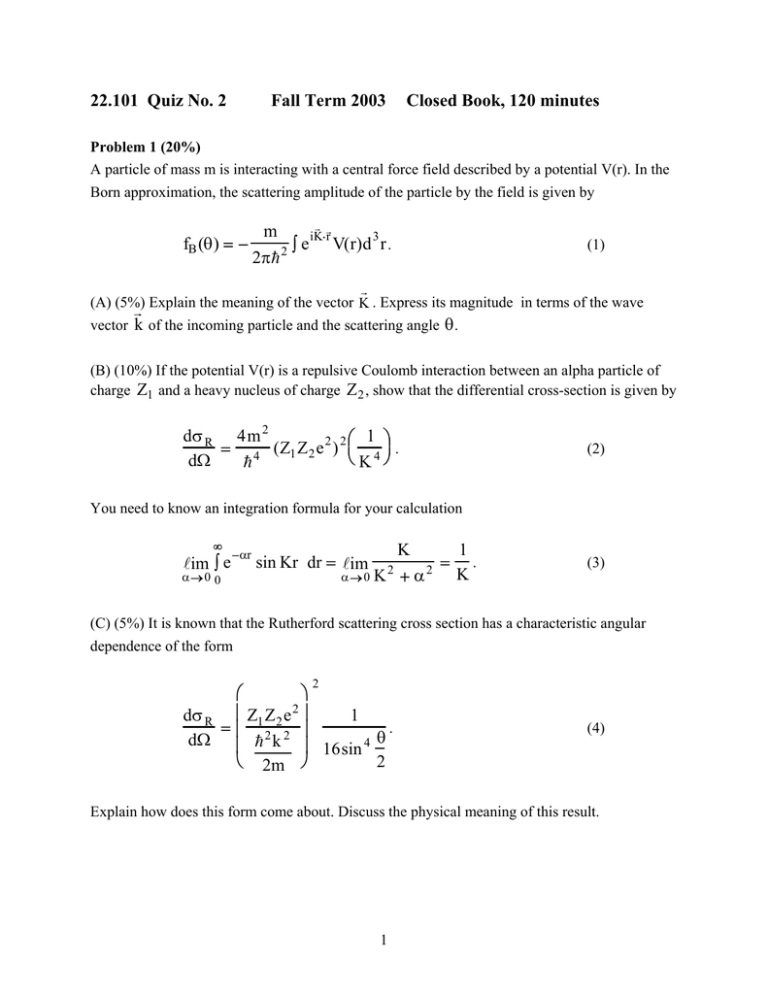
22.101 Quiz No. 2 Fall Term 2003 Closed Book, 120 minutes Problem 1 (20%) A particle of mass m is interacting with a central force field described by a potential V(r). In the Born approximation, the scattering amplitude of the particle by the field is given by fB (θ) = − m 2π 2 ∫e iK⋅ r V(r)d 3 r . (1) (A) (5%) Explain the meaning of the vector K . Express its magnitude in terms of the wave vector k of the incoming particle and the scattering angle θ . (B) (10%) If the potential V(r) is a repulsive Coulomb interaction between an alpha particle of charge Z1 and a heavy nucleus of charge Z 2 , show that the differential cross-section is given by dσ R 4m 2 ⎛ 1 ⎞ = 4 (Z1 Z 2 e 2 ) 2 ⎜ 4 ⎟ . ⎝K ⎠ dΩ (2) You need to know an integration formula for your calculation ∞ im ∫ e −αr α→ 0 0 K 1 . = 2 2 K α→ 0 K + α sin Kr dr = im (3) (C) (5%) It is known that the Rutherford scattering cross section has a characteristic angular dependence of the form 2 ⎞ ⎛ 2 dσ R ⎜ Z1 Z 2 e ⎟ 1 =⎜ 2 2 ⎟ . dΩ ⎜ k ⎟ 16sin 4 θ ⎝ 2m ⎠ 2 (4) Explain how does this form come about. Discuss the physical meaning of this result. 1 Problem 2 (20%) It was shown in the class that the stopping power of a heavy charged particle in passing through a mono-atomic material is given by the Bethe-Bloch formula ⎡ ⎛ 2m V2 ⎞ ⎛ V2 ⎞ V2 ⎤ dE 4πe 4 z2 e ⎢ − = ⎟ − ln ⎜ 1 − 2 ⎟ − 2 ⎥ . 2 (nZ) ⎢ ln⎜ I dx ⎠ ⎝ meV c ⎠ c ⎦⎥ ⎣ ⎝ (5) (a) 5% Explain all the physical parameters in the formula and sketch the energy dependence of the stopping power for the case of a proton (the heavy charged particle). (b) 10% Derive from the stopping power formula the range (R) of the charged particle in the material and show that it can be written in the form of a scaling law for the range . ⎛ M⎞ ⎛ 1 ⎞ R (V0 → 0 ) = ⎜ 2 ⎟ ⎜ ⎟ F(V0 ) . ⎝ z ⎠ ⎝ nZ ⎠ (6) (c) 5% State the implications of this scaling law in terms of different charged particles, such as protons and alpha particles and of the kind of material medium. Explain why the concept of the mass stopping power is useful. Problem 3 (15%) Describe the physical process of Thomson scattering of x-rays by a free electron. Show that the total cross-section of the Thomson scattering is 2 8π ⎛ e 2 ⎞ σ TH = ⎜ ⎟ 3 ⎝ mc2 ⎠ . (7) It will be helpful for you to go through the following steps: 1. Take the incident field as E inc = εˆE 0 cos(k ⋅ r − ωt) , where k is the wave vector of the 2. incident plane wave (in the x-direction) and εˆ , the unit vector in the direction of polarization(say in the z-direction).. The scattered field at a far field position r , where the detector (subtending a solid angle e zÝ)] , where kˆ' is the unit vector in the dΩ ) is located, is given by E sc = 2 [kˆ '× (kˆ '× Ý c r 2 3. direction of the scattered wave vector (also in the direction of r ). Ý zÝis the acceleration of the free electron under the influence of the incident wave. The scattered field has a e zÝ|sinξ , where ξ is the angle between polarization of the incident magnitude | E sc| = 2 | Ý cr wave and the direction of the scattered wave. Calculate the magnitude of Poynting vectors (the energy flux) of the incident and scattered waves according to the formula (5%), | S |= c | E |2 . 4π (8) 4. Calculate the differential cross-section (polarized) in terms of these magnitudes of the 5. Poynting vectors (5%). Average overall the possible directions of the polarization vector, namely, show that (5%), sin 2 ξ = 6. 1 (1 + cos2 θ) . 2 (9) Integrate the differential cross-section over all solid angle to get the final result (5%). Problem 4 (25%) This question is to ask you to explain the quantum mechanical origin of the experimental fact that the alpha decay constant depends very strongly on the energy of the alpha particles emitted. 238 emits alpha particles of energy E α = 4.1MeV with a For example, it is known that 92 U 9 half life T1 / 2 = 4.5 × 10 years = 1.42 × 10 energy E α = 8.8MeV with a half life T1 / 2 17 212 sec , while 84 Po emits alpha particles of −7 = 3.0 × 10 sec . If it is remarkable that the decay constants of the two radioactive nuclei differ by 24 orders of magnitude resulting from merely factor 2 differences in the alpha particle energies. You are asked to explain this fact by the well-known Gamow theory. (A)(10%) Explain briefly the Gamow theory of alpha decay constant λ . (B)(5%) Explain plausibly that the decay constant of the alpha emission can be written as λ = λ 0T = λ 0e −G . (10) Give the expression of the pre-factor λ 0 in equation (10) and show that it’s magnitude is 3 21 −1 approximately equal to 10 sec . T is the transmission probability of the nuclear Coulomb barrier and G is the so-called Gamow factor, approximately equal to G= 8mα ze 2 Z . Eα (11) Explain the meaning of different symbols in this equation. (C)(10%) Show that the following relation can be derived from the above equations, (5) and (6): 8mα ze 2 log10 λ = logλ 0 − (log e)G = 21 − 2.303 Z Z .(12) = 21 − 1.0941 E α (MeV) Eα Use this relation to work out the ratio of the decay constants between 84 Po 212 and 92 U 238 . Problem 5. (20%) (a) (5%) If the beta decay is a result of a transition between two sharp nuclear energy levels, why is the spectrum of the emitted beta particles continuous? Give a physical postulate which was put forth by W. Pauli in 1930 to explain away this mystery. (b) (10%) The beta spectrograph measures a quantity proportional to : N(p) dp = the no of beta particles emitted with momenta in the interval (p, p + dp). Give a qualitative argument based on the existence of neutrino that the momentum distribution function is of the form N(p)dp = cons tan t ⋅ (E 0 − E ) 2 F(E, Z)p 2dp . (11) and explain various symbols in this equation. (c) (5%) Give the well-known plot that is used to determine the maximum energy value (the energy end point) of the spectrum? 4

